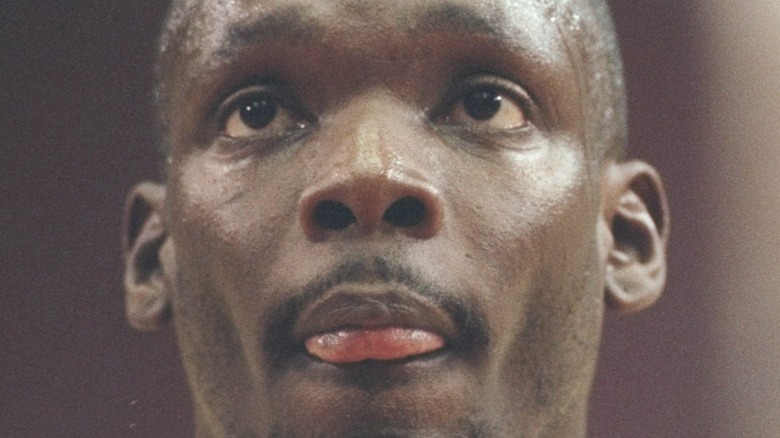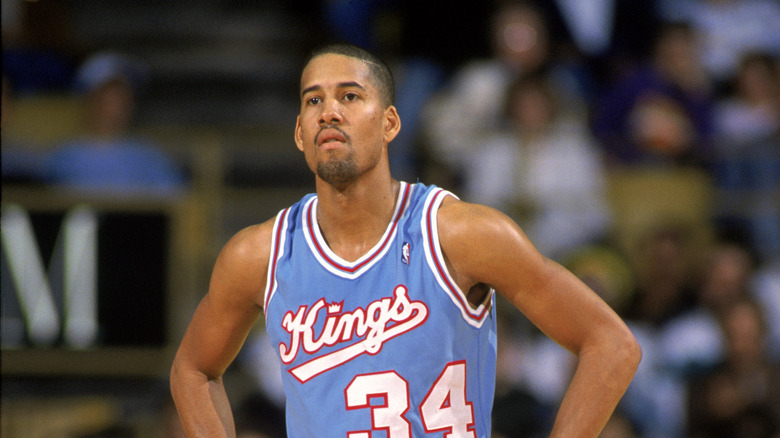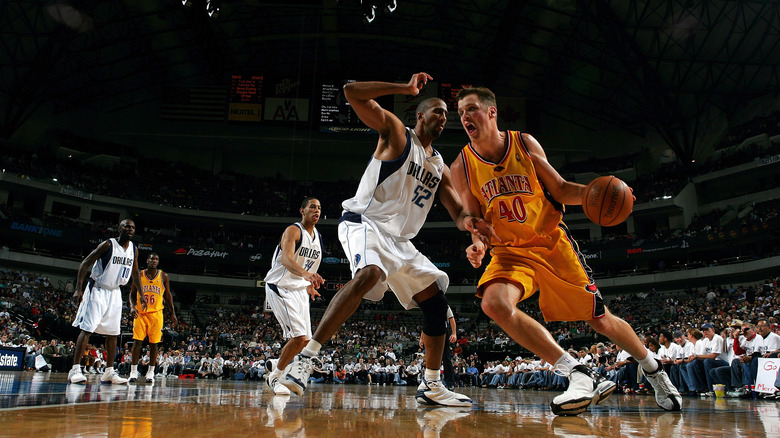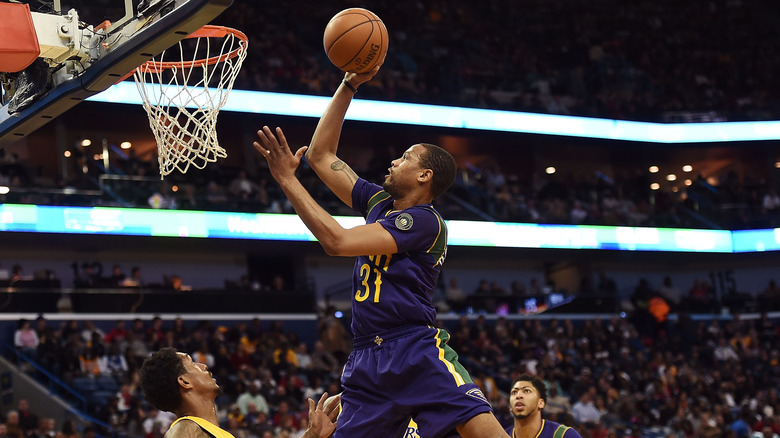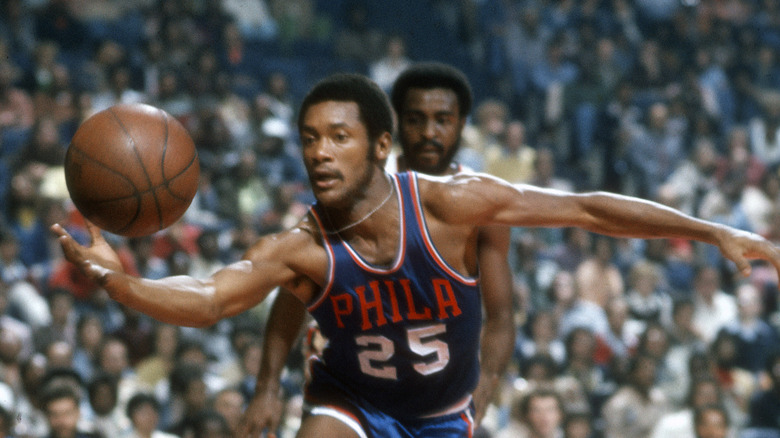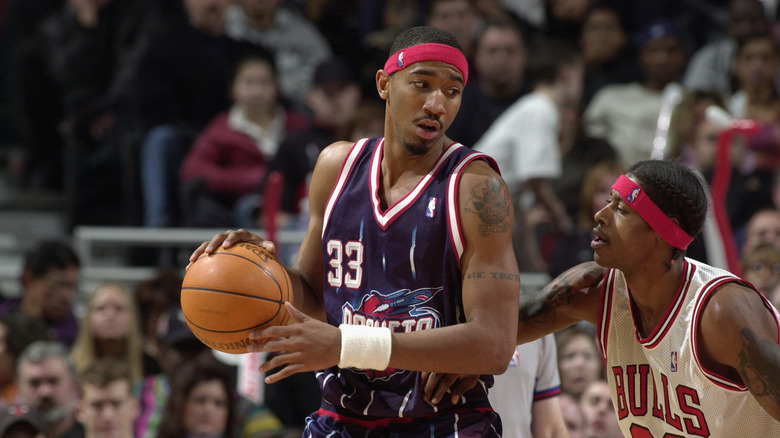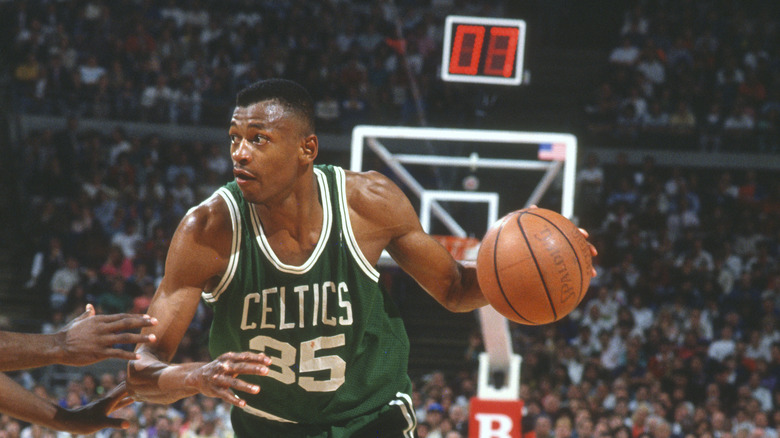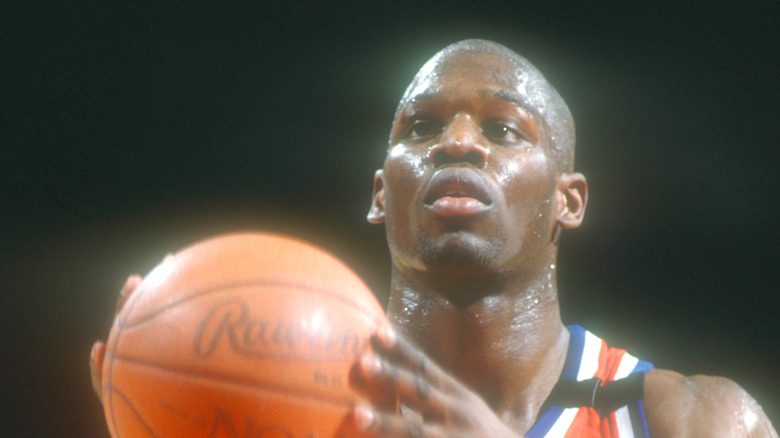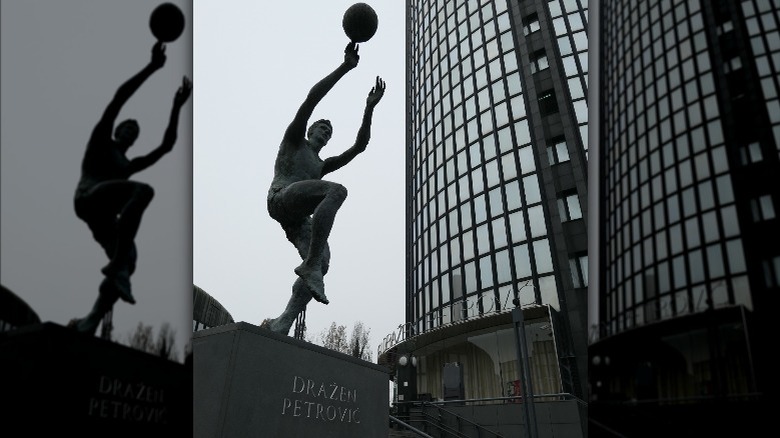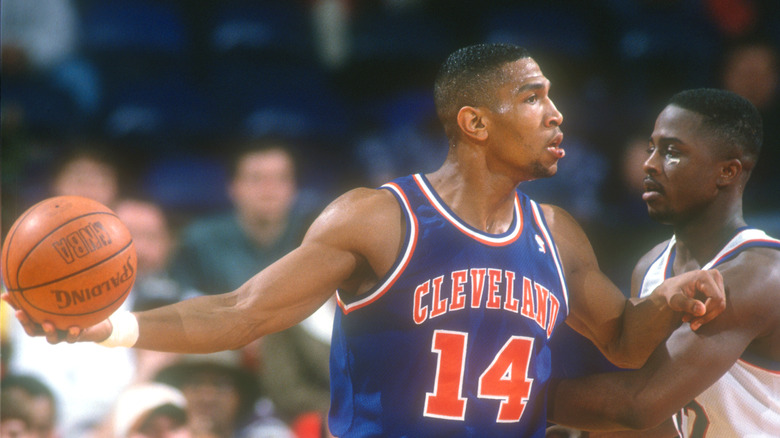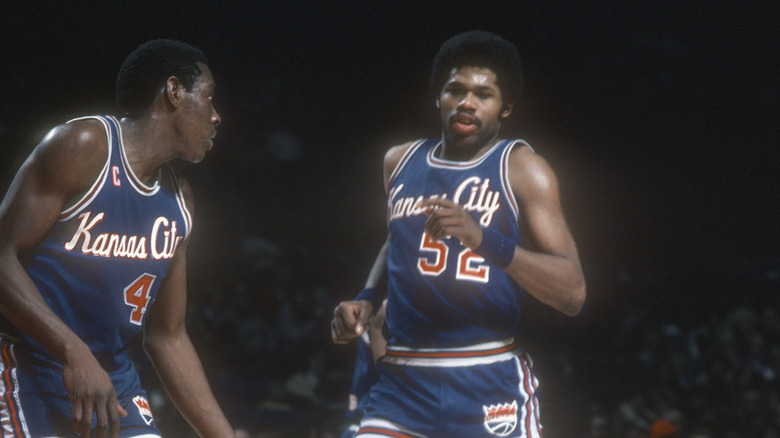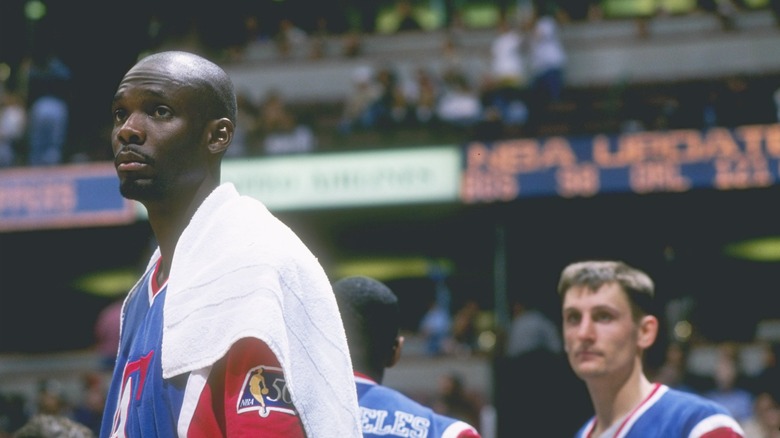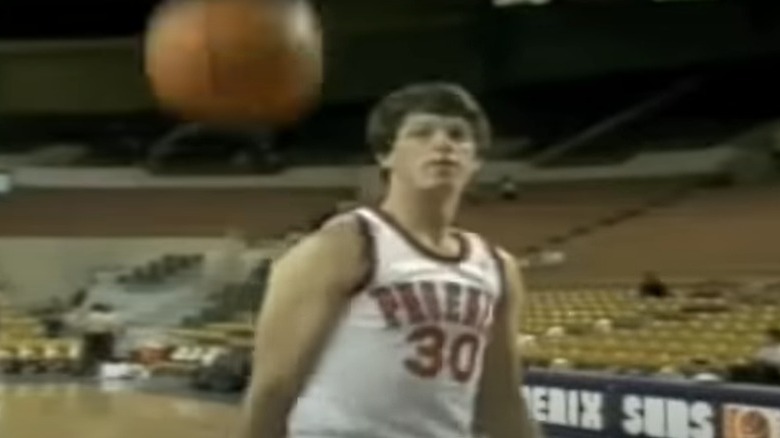NBA Players Who Died Before Turning 40
Making it to the NBA is such a difficult achievement that it's easy to assume anyone who gets there is set for life. Sure, being a professional athlete is difficult, but all the fame, money, and security definitely make up for it. Most regular people would probably trade lives with even the worst player on the worst NBA team in a second.
But just because someone is famous and rich doesn't mean they are insulated from disaster. A surprising number of NBA players have died before they even reached 40, most long before. The reasons vary from tragic accidents to drug use to underlying medical issues, but each untimely death hit their families, teams, and fans incredibly hard.
Losing anyone is difficult, but when someone young, who seems to have their whole life ahead of them, dies suddenly and unexpectedly, the blow can be unbearable. Here are NBA players who died before turning 40.
Ricky Berry
After graduating from San Jose State University, where he was coached by his father, Ricky Berry was drafted a respectable 18th by the Sacramento Kings, per Basketball Reference. During the 1988-89 season, he averaged 11 points a game, but his true potential would never be known. After playing just 64 games in the NBA, only weeks before his 25th birthday, Berry died by suicide on August 14, 1989.
Even in such a short period with the team, Berry had made an impression. When announcing the tragic event to the media, the Kings' coach was so upset that he was unable to choke out his prepared statement, The New York Times reported. Future Portland Trail Blazer Monty Buckley, then a high school student who'd been mentored by Berry, was pulled aside at the basketball camp he was attending and told the news. He couldn't believe it. "He was a two-way player, as we say today, who could play all five positions," Buckley later said (via Andscape). "He had a chance to be one of the best in the game."
While at the time it was reported that no one had seen his death coming, later it would emerge Berry was having many problems in his personal life, including with his parents and his new wife, as well as financial stress.
If you or anyone you know is having suicidal thoughts, please call the National Suicide Prevention Lifeline by dialing 988 or by calling 1-800-273-TALK (8255).
Len Bias
Len Bias, the subject of an ESPN 30 for 30 documentary, was an NBA player who never got to play a single game. After an astonishing run at The University of Maryland, Bias was selected second in the 1986 NBA draft (pictured). No one doubted he would be a star, and still, to this day, sports fans debate just how dominant he would have been. But that's all it is, a hypothetical mental exercise, since only two days after he was drafted by the Boston Celtics, Bias collapsed in his dorm room and died shortly after, The Washington Post reported.
Because the heart of a healthy 22-year-old suddenly stopping is incredibly rare, drugs, specifically cocaine, were immediately suspected. But those who knew Bias thought that was unlikely. On the 20th anniversary of his death, Baltimore's Press Box spoke to those who knew Bias at the time. Jeff Baxter, who had roomed with Bias all four years of college, said, "I would have bet my life on the fact that Lenny wouldn't have used drugs, and also that it would have been the first time." When cocaine was confirmed, the whole conversation around the drug changed, with one commentator (via The Washingtonian), calling Bias' death "the most socially influential moment in the history of modern sports."
If you or anyone you know needs help with addiction issues, help is available. Visit the Substance Abuse and Mental Health Services Administration website or contact SAMHSA's National Helpline at 1-800-662-HELP (4357).
Jason Collier
Jason Collier was the 15th pick of the 2000 NBA Draft, according to Basketball Reference, and while he was originally selected by the Milwaukee Bucks, they traded him that same day to the Houston Rockets. In 2004, he'd go on to play for the Atlanta Hawks, but his career with them would be cut short when he died suddenly on October 15, 2005, barely a month after his 28th birthday.
After an autopsy, it was revealed Collier had an underlying heart condition no one was aware of. While those who knew and loved him might have remembered him as having a metaphorical big heart, what killed him was a literal big heart. Too big. ESPN quoted Georgia's chief medical examiner as saying that the sheer size of Collier's heart "was above the accepted limits, even for a man of his size." The college newspaper Technique explained that while an average-sized man's heart weighs in at around 400-450 grams, a large basketball player could be expected to have one weighing as much as 580 grams. Collier's heart? A whopping 640 grams.
While you might think having an enlarged heart would be easy to diagnose, especially considering all the medical tests and health checks basketball players have to go through to be cleared to play, the medical examiner said it's actually quite difficult to assess. The only sign something was off was some slightly abnormal EKG results Collier had gotten twice before, but nothing that indicated anything major was wrong.
Bryce Dejean-Jones
Bryce Dejean-Jones did not have the easy route to the NBA that some on this list did. After no team selected him in the 2015 NBA Draft (per the NBA), he would sign a deal with the New Orleans Pelicans, only to have an on-off relationship with them for the 2015-16 season. After waiving Dejean-Jones months after signing him, according to Basketball Reference, the team then signed him to successive 10-day contracts, before finally agreeing to a 3-year contract in February 2016. One week later, surgery on his wrist ended Dejean-Jones' season. Not that anyone could have known at the time, but it was also the end of his career.
The death of Bryce Dejean-Jones occurred only months later, in May 2016, after he kicked in the door of a stranger's apartment and was shot by the occupant, per ESPN. He was 23.
According to Bleacher Report, it would later emerge that Dejean-Jones was angry and drunk, a combination that had gotten him in trouble before. Thinking his girlfriend had locked him out of her apartment, he beat on the front door until he broke the deadbolts and entered. The problem was (among other things), it wasn't her apartment — it was the home of a teacher who had no idea who Dejean-Jones was. As the police explained in a statement (via Sporting News), after being woken by someone loudly breaking into his apartment, then calling out and getting no answer, the resident grabbed a gun. When Dejean-Jones kicked in the bedroom door, the resident shot him in the stomach.
Terry Furlow
Even though he only played in the NBA for a few years after dominating the basketball program at The University of Michigan, Terry Furlow had an outsized influence on many iconic players. In his time with the Cleveland Cavaliers, Atlanta Hawks, and Utah Jazz, per MLive, he was not only a teammate and good friend of Julius "Dr. J" Erving, but a key mentor for the up-and-coming high schooler Earvin "Magic" Johnson. Johnson would later call Furlow "one of the greatest shooters I've ever seen in my entire life."
But Furlow's career came to an abrupt end on May 23, 1980, when he was 25. According to Deseret News, Furlow had been out partying, and was driving home early the next morning when he hit a utility pole and died.
When the toxicology report came back and revealed Furlow had cocaine and Valium in his system, the NBA was forced to grapple with the fact there was a serious drug problem in its ranks. "Before Terry Furlow died, I think there was a desire to see a player really get nailed on a drug charge, that might open some eyes. But since his death, I think most players feel, 'It won't happen to me. It's too bad about Terry, but it won't happen to me,'" Phoenix's general manager Jerry Colangelo told The Washington Post at the time.
If you or anyone you know needs help with addiction issues, help is available. Visit the Substance Abuse and Mental Health Services Administration website or contact SAMHSA's National Helpline at 1-800-662-HELP (4357).
Eddie Griffin
Eddie Griffin emerged as a gifted basketball player at a young age. He would make it to the NBA to play with the Minnesota Timberwolves and the Houston Rockets in a career spanning the 2001-2007 seasons, per Basketball Reference.
But Griffin had issues with drug and alcohol misuse, spending at least one spell in rehab. In March 2007, after those issues resulted in the NBA handing down a substance abuse suspension, Griffin was let go by the Timberwolves. While he hoped to make a comeback, sadly, on August 17, 2007, the 25-year-old was driving his car while three times over the limit, according to ESPN. The injuries resulting from Griffin crashing the SUV into the side of a train were so bad, he could only be identified by his dental records.
At his funeral, covered by local Philadelphia newspaper The Bulletin, those who knew Griffin kept coming back to the issues the player never stopped trying to overcome. "People don't understand that people who go through addiction – that the true person is still in there and it's just a matter of getting back to being that person. I think Eddie was on his way," Nate Blackwell, a former assistant coach who'd worked with Griffin said. "It's unfortunate that this happened before we had a real chance to see that kid emerge again."
If you or anyone you know needs help with addiction issues, help is available. Visit the Substance Abuse and Mental Health Services Administration website or contact SAMHSA's National Helpline at 1-800-662-HELP (4357).
Reggie Lewis
Reggie Lewis managed to stand out even on a high school basketball team that included three other future NBA players, according to Slam. He went on to dominate at Northeastern, before being drafted 22nd in the 1987 NBA Draft by the Boston Celtics, per Basketball Reference.
Then, on July 27, 1993, during a routine practice session, Lewis collapsed on the court, Sports Illustrated reported. Despite attempts at resuscitation, he died, aged just 27. As with other young players whose hearts suddenly stopped for seemingly no reason (including Len Bias, who, had they both lived, might have been a teammate of Lewis and totally changed the arch of '90s basketball, according to Bleacher Report), cocaine use was suspected.
However, years later, a more complicated picture emerged in a court case brought by Lewis' widow. While experts agreed that scarring of the heart muscles and a cardiac arrhythmia ultimately killed Lewis, they disagreed about what had caused those issues. The medical examiner who did the player's autopsy didn't believe there was any evidence of cocaine use, and that the scarring had been caused by a virus. Previously, Lewis had been told by a team of no less than a dozen doctors that he had a dangerous heart arrhythmia. However, Lewis' cardiologist said the player told him about his cocaine use only weeks before he died, and at least five consultants believed the scarring could be due to using cocaine.
Conrad McRae
After graduating from Syracuse, Conrad McRae was drafted in the second round in 1993 by the Washington Bullets. However, he never actually played for the NBA team, instead spending the next seven seasons playing almost exclusively in Europe, where he did well for himself. But according to The Los Angeles Times, the NBA dream was still there, so in the summer of 2000 he came back to the U.S., where he had a tryout with the Dallas Mavericks, and to play for the Orlando Magic and the New Jersey Nets in their summer leagues, The New York Times reported.
The year before, McRae had signed a 10-day contract with the Denver Nuggets, but the goal of playing for the NBA was snatched away when he fainted before what would have been his first game, and the Nuggets released him.
It was a sign of worse to come. On July 10, 2000, the first day of practice with the Magic, McRae collapsed on the court, in full cardiac arrest. He died aged 29, less than a month before his wedding would have been held. While an initial autopsy didn't specify a cause of death, McRae had a history of heart arrhythmias, which could have caused his fainting spell the year before and was widely accepted to have been the reason his heart stopped so suddenly.
Dražen Petrović
Dražen Petrović was born in Croatia (then part of Yugoslavia) and started his basketball career in Europe before finally being drafted in the 3rd round of the NBA Draft in 1986. He would play for the Portland Trail Blazers and the New Jersey Nets for the next four seasons, per Basketball Reference, and emerge as one of the NBA's best shooting guards. He also made appearances at three Olympics, leading Yugoslavia and then Croatia to a haul of one bronze and two silver medals.
In Germany, on June 7, 1993, the 28-year-old Petrović was a passenger in a car driven by his girlfriend. The New York Times reported it had been raining, and the woman lost control of the car, crashing into a tractor-trailer. The girlfriend and another woman in the car were injured, per The Los Angeles Times; Petrović was killed on impact.
Petrović was mourned on both sides of the Atlantic. "He left no stones unturned trying to make himself the best player he could be," Nets' general manager Willis Reed told the media while sobbing. "We don't have enough players in this game that care that much about it." But nowhere was Petrović's loss felt more than in Croatia, where he was arguably their most successful athlete ever. There, they renamed a basketball arena and a city square for him, according to the Olympics website, as well as opened a museum dedicated to Petrović. And in Switzerland, a statue of the player (pictured) was erected near the Olympics Museum.
Bobby Phills
Bobby Phills was drafted 45th overall in 1991 by the Milwaukee Bucks, although he never ended up playing for them. His nine seasons in the NBA would instead be split between the Cleveland Cavaliers and the Charlotte Hornets, according to Basketball Reference.
Phills had just turned 30 only a couple weeks before, when, on January 12, 2000, he was involved in a three-car accident and died, The New York Times reported. Early reports indicated Phills had been racing his Porsche at an extremely high speed in a 45 MPH zone. Phills' teammate, David Wesley, the one racing him in another car, was unharmed. Phills lost control of his car and crashed into two others; the occupants of those cars were injured but survived. However, Phills was killed instantly, and the crash was so bad that it took emergency responders over two hours to be able to remove his body from his car.
Per ESPN, Phills' teammates on the Hornets were so upset at the news that they asked the NBA to postpone two of their games. However, Phills' widow encouraged them to keep going. "If the players can emotionally handle it, I would want them to go out and play because that's what Bobby would want," she said. According to FOX8, the Charlotte Hornets retired Phills' number after he died; as of 2022, it remains the only jersey number retired by the team.
Bill Robinzine
Despite not even taking up basketball until he was 17, Bill Robinzine was a 1st round draft pick in 1975, being selected by the Kansas City Kings. However, starting in 1980, he would go on to be traded in quick succession from the Kings to the Cleveland Cavaliers, then to the Dallas Mavericks, and finally to the Utah Jazz, according to Basketball Reference. However, at the end of the 1982 season, he found himself without an NBA team for the first time in years. The New York Times reported that Robinzine was looking into joining a European team.
So when the player died by suicide on September 16, 1982, aged 29, his friends and family were shocked. Another article in the Times reported that while Robinzine was having some financial issues, they were nothing that couldn't be dealt with relatively easily, and while he was sad not to be playing in the NBA at that point, he had discussed the possibility of playing in Italy with many of his friends in the weeks before he died. He was happily married and seemed to have a bright future, even if the NBA was behind him.
A college teammate said, "It seemed like he had a million different options," while Robinzine's college coach told a reporter, "He was all smiles. He never had any problems. He never told us any."
If you or anyone you know is having suicidal thoughts, please call the National Suicide Prevention Lifeline by dialing 988 or by calling 1-800-273-TALK (8255).
Malik Sealy
Malik Sealy was an all-around fascinating person. According to ESPN, his father had been a bodyguard for Malcolm X, and Malik was named after a name the civil rights leader adopted after he converted to Islam. While Sealy was in the NBA, he also managed to fit in various acting roles. And despite already playing for seven seasons at that point, in 1999-2000, his second season with the Minnesota Timberwolves, he managed to drastically increase his shooting percentage.
On May 20, 2000, the 30-year-old Sealy was driving home from a dinner with teammates when he was struck by a pickup truck going the wrong direction on the highway. Sealy was not wearing a seatbelt and was killed. The driver of the pickup was over twice the legal limit, The Star Tribune reported. He eventually pleaded guilty to criminal vehicular homicide and spent about three years behind bars. However, after his release, he was arrested for DUIs again repeatedly.
The NBA had already been rocked by the loss of Bobby Phills in a car accident five months earlier, so Sealy's death was a double whammy. Kevin McHale, vice president of basketball operations for the Timberwolves said, "We're in shock. Malik was one of the most popular players in our locker room, and one of the biggest reasons behind our turnaround and success this past season on the court."
Nick Vanos
According to the NBA, after an impressive four years at Santa Clara, Nick Vanos was a 2nd round draft pick in 1985. Phoenix Suns teammate Alvan Adams remembered how happy Vanos was to be there. "In his first year, he was like, 'Wow, I'm in the NBA,'" Adams remembered. The team saw great potential in Vanos and saw him as a possible key to success in the future. Sadly, his time with them would only last two seasons.
On August 16, 1987, Vanos was on Northwest Airlines Flight 255 with his girlfriend, when it crashed during takeoff. The disaster killed over 150 of the plane's passengers, including Vanos. He was 24.
There is a virtual memorial to the victims of the crash, as well as a physical memorial that the families spent seven years fighting to erect. One mother who lost her pregnant daughter in the disaster said, "It's been a very hard 7 years. This will bring a new meaning to the crash. We only wish it would have been sooner."
His parents would go on to sue the airline, UPI reported, for $13.8 million, alleging the pilot took off "contrary to and in violation of safe operating procedures." They based the figure on all the money they said Vanos would have earned as a player and for endorsement deals.
